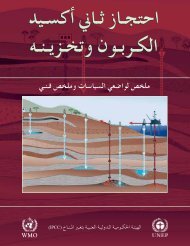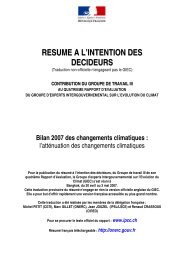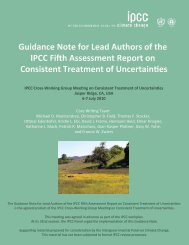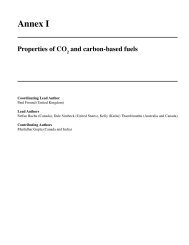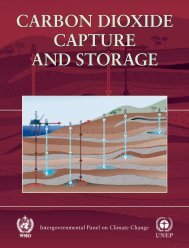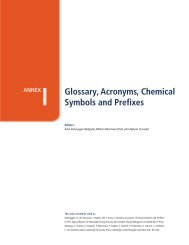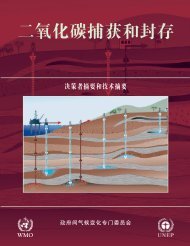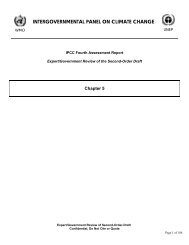SODBatch A&B SPM Comments co-chair response final ... - ipcc-wg3
SODBatch A&B SPM Comments co-chair response final ... - ipcc-wg3
SODBatch A&B SPM Comments co-chair response final ... - ipcc-wg3
Create successful ePaper yourself
Turn your PDF publications into a flip-book with our unique Google optimized e-Paper software.
Chapter-<br />
Comment<br />
<strong>SPM</strong>-<br />
634<br />
<strong>SPM</strong>-<br />
635<br />
<strong>SPM</strong>-<br />
636<br />
<strong>SPM</strong>-<br />
637<br />
<strong>SPM</strong>-<br />
638<br />
<strong>SPM</strong>-<br />
639<br />
para<br />
Batch<br />
From Page<br />
From Line<br />
To Page<br />
To line<br />
<strong>Comments</strong><br />
IPCC WGIII Fourth Assessment Report, Se<strong>co</strong>nd Order Draft<br />
Expert Review of Se<strong>co</strong>nd-Order-Draft<br />
Confidential, Do Not Cite or Quote<br />
Response suggested by <strong>co</strong><strong>chair</strong>s<br />
0 A 8 22 9 1<br />
(VARET jacques, French Geological Survey)<br />
Add a figure in order to show that the peak for oil and gas resources<br />
do well occur in the period <strong>co</strong>nsidered (see proposed figure, from J.<br />
Varet, Futuribles 2005).<br />
(VARET jacques, French Geological Survey)<br />
See A-633<br />
7 A 8 22 0 0 Footnote 4: It might be worth adding that (to my knowledge) most<br />
of these top-down models also assume perfect substitutability<br />
between sectors, and no transaction or transition <strong>co</strong>sts.<br />
(Andy Reisinger, TSU IPCC Synthesis Report)<br />
ACC; add to caption fig 5<br />
7 A 8 24 0 0 Footnote 5: Include in the main text. This is an important<br />
ACC; add annual GDP growth<br />
alternative metric to "loss of GDP".<br />
(Harald Winkler, University of Cape Town)<br />
rate impact between brackets<br />
7 A 8 0 0 0 Figure <strong>SPM</strong>.5<br />
See A-593<br />
F<br />
The model of E3MG showing the negative value of GDP losses<br />
5<br />
presumes a mechanism that the larger carbon tax is imposed, the<br />
larger investments may take place by the revenue obtained through<br />
the carbon tax, and then employment increase and GDP increase<br />
will follow. In reality the carbon tax will work to diminish<br />
e<strong>co</strong>nomic activities because of the higher energy prices, and GDP<br />
in total will be decreased. However, the model does not <strong>co</strong>nsider<br />
these effects. The model presumptions <strong>co</strong>uld be justified for short<br />
time periods; however, for a long time span such as up to 2050 and<br />
2100, the presumed mechanism can never justified. For these<br />
reason, we strongly re<strong>co</strong>mmend you to delete this model results in<br />
Figure <strong>SPM</strong>.5 and together with relevant reference in the text.<br />
(Government of Japan)<br />
7 A 8 0 0 0 Figure <strong>SPM</strong>.5<br />
REJ; too <strong>co</strong>mplex<br />
F<br />
Describing GDP loss in terms of proportion can be misleading as it<br />
5<br />
seems to give the wrong perception that the loss is rather small.<br />
We suggest to add the information on "net present value (NPV) of<br />
abatement <strong>co</strong>sts" as in TS, Figure TS 15(b).<br />
(Government of Japan)<br />
7 A 8 0 0 0 figure <strong>SPM</strong>.5: suggest to turn the x-axis as lower stabilisation levels UNCLEAR<br />
F<br />
imply higher <strong>co</strong>sts<br />
Action<br />
for<br />
chapter<br />
Considerations<br />
by the writing<br />
team<br />
Page 164 of 348



